Grenades
My Main Goal Is to Blow Up
Reference: TC 3-23.30 Hand Grenades

Overview
Grenade usage is one of the many basic skills a cadet should know. There are several grenade types to memorize and a grenade course to pass at CST. This article covers everything grenade-related.
Hand grenades significantly increase combat effectiveness and survivability. They can be used in all sorts of scenarios to:
- Eliminate enemy threats
- Mark positions
- Create obstructions
- Surprise enemy forces
- Destroy or disable enemy equipment
Safety First
Of course, it’s critical to take safety precautions when handling these small explosive devices.
Before using grenades, keep these tips in mind:
- Inspect all grenades for serviceability before use.
- Know where friendly forces are located.
- Know your sectors of fire.
- Ensure the projected area of the grenade is clear of obstacles.
- Ensure you are wearing your PPE (ACH, gloves, ear pro, eye pro, body armor).
- Identify your target and its surroundings.
- Keep the grenade stowed until ready to use.
Warning
Never cook off a grenade unless specifically trained and authorized. The M67 has a 4–5 second fuse — cooking it risks detonation in your hand.
Grenade Types
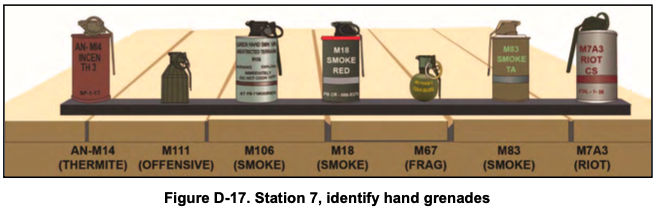
The Army currently uses six basic types of grenades:
- Training/Practice Grenades: Used for training (e.g., M69 blue practice grenade).
- Fragmentation Grenades: Project high-velocity fragments to eliminate enemy threats.
- Offensive Grenades: Less lethal in open areas but highly effective in confined spaces.
- Nonlethal Grenades: Used for diversion, disorientation, or crowd control.
- Chemical Grenades: Used for incendiary effects, screening, or riot control.
- Smoke Grenades: Used to signal aircraft, mark positions, or conceal movement.
Here is a quick chart with all grenade types and specs:
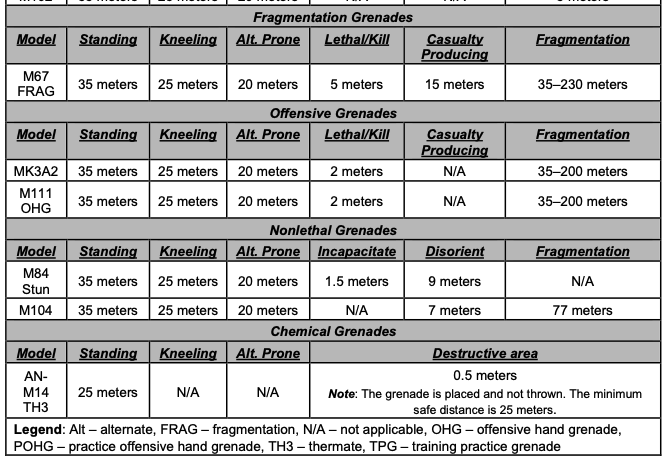

You must memorize all of these grenade types shown below — you will be tested at CST.
M67 Fragmentation Grenade

- Used to disable or kill enemy threats.
- Explodes 4 to 5 seconds after the safety lever is released.
- Effective casualty-producing radius: 15 meters.
- Killing radius: 5 meters.

Caution
Even though the killing radius is 5 meters and the casualty-producing radius is 15 meters, fragments can travel as far as 230 meters. Always take cover immediately after throwing.
MK3A2 Offensive Grenade
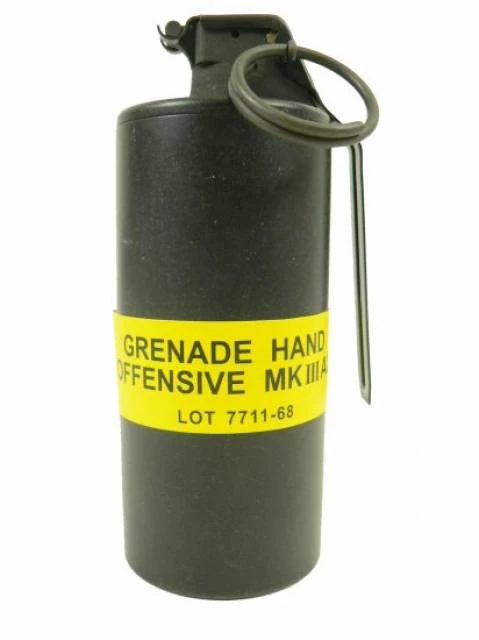
The M67 weighs approximately 14 oz and contains 6.5 oz of Composition B explosive. It is the standard fragmentation grenade for U.S. forces.
Produces a large blast overpressure with minimal fragmentation. Fuse delay: 4–5 seconds. Effective in rooms up to 10x10 feet.
- Used for concussion effects on enemy threats.
- Ideal in fortified or enclosed locations (bunkers, buildings).
- Can be used for blasting and demolition tasks.

M84 Flash Bang Stun Grenade
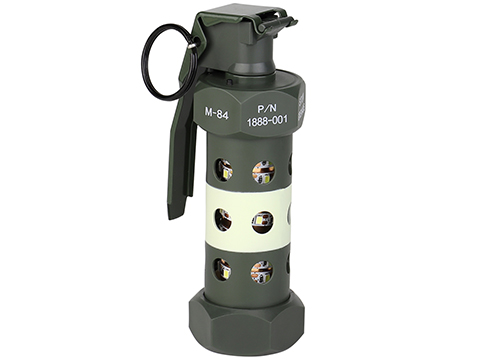
Fuse delay: 1.5–2.3 seconds. Do not throw directly at personnel at close range — can cause permanent hearing or vision damage.
- Used to disorient and confuse enemy threats.
- Nonlethal device that emits a blinding flash (~8 million candela) and 170–180 dB blast.
- Damages eyesight and night vision in low-light conditions.
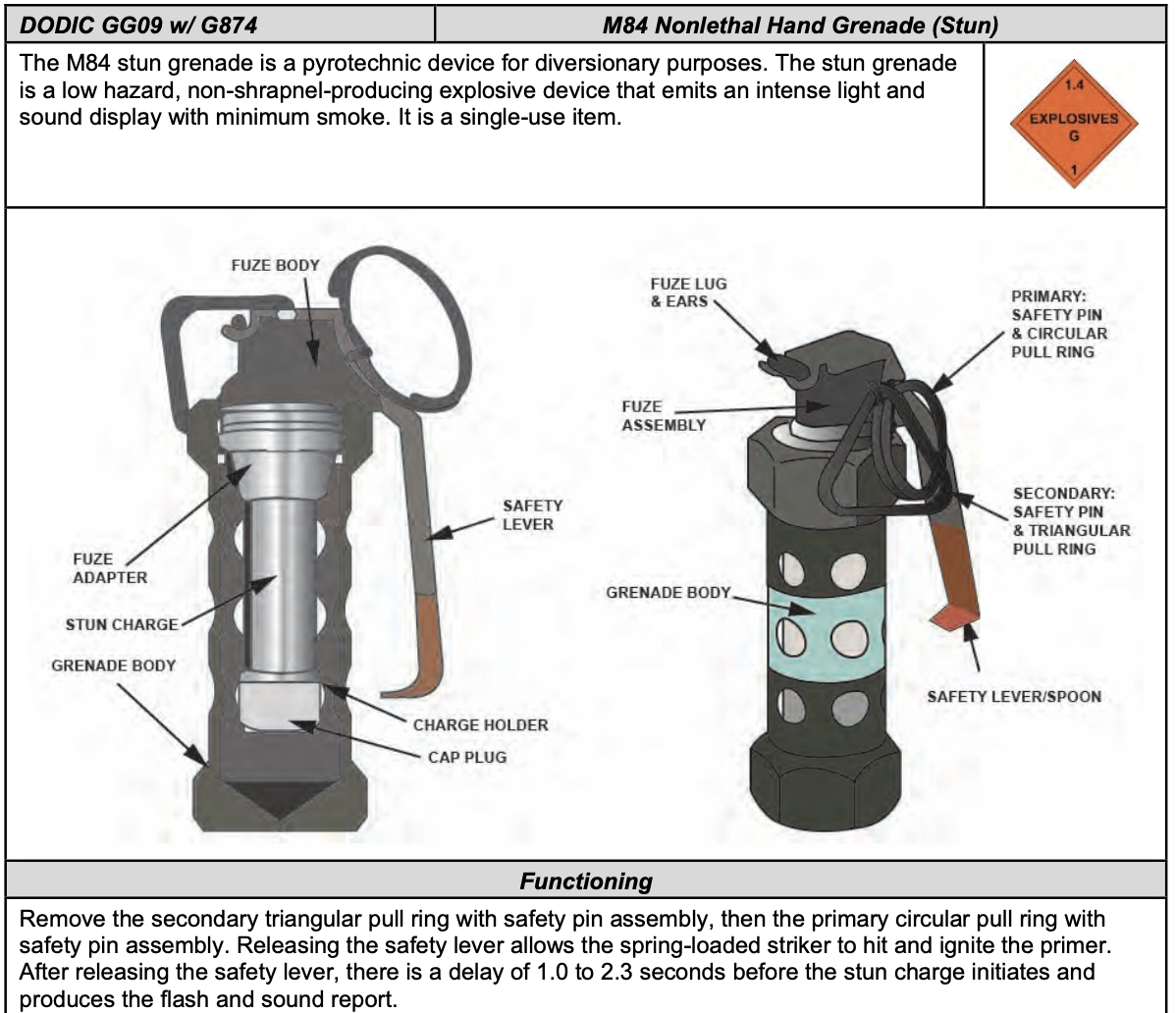
M18 Colored Smoke Grenade

Burn time: 50–90 seconds. Available in red, yellow, green, violet. Never use white smoke near friendly positions — it may be mistaken for a marking round.
- Used for screening movement.
- Used for signaling (aircraft, ground units).

AN-M14 TH3 Incendiary Hand Grenade
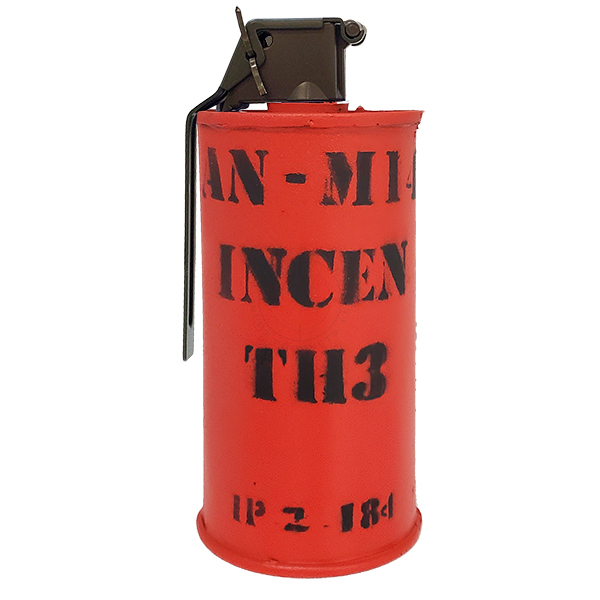
Contains thermate (TH3), burns at ~4,000°F for 40 seconds. Can penetrate 1/2 inch of steel. Extremely dangerous — avoid use near friendly forces or in dry brush.
- Used to destroy equipment (vehicles, weapons, supplies).
- Used to start fires in flammable environments.
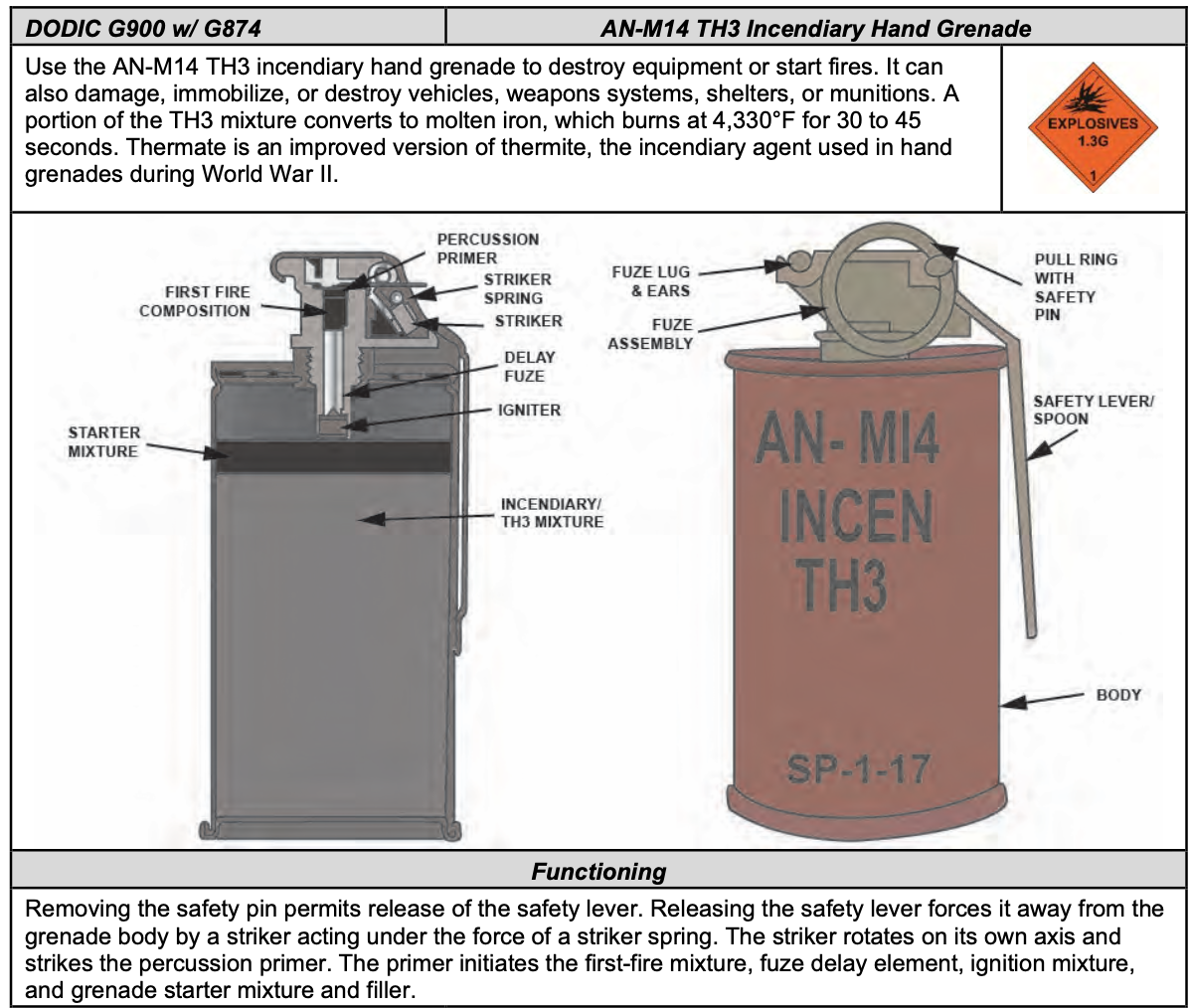
M7A3 Riot Control Hand Grenade
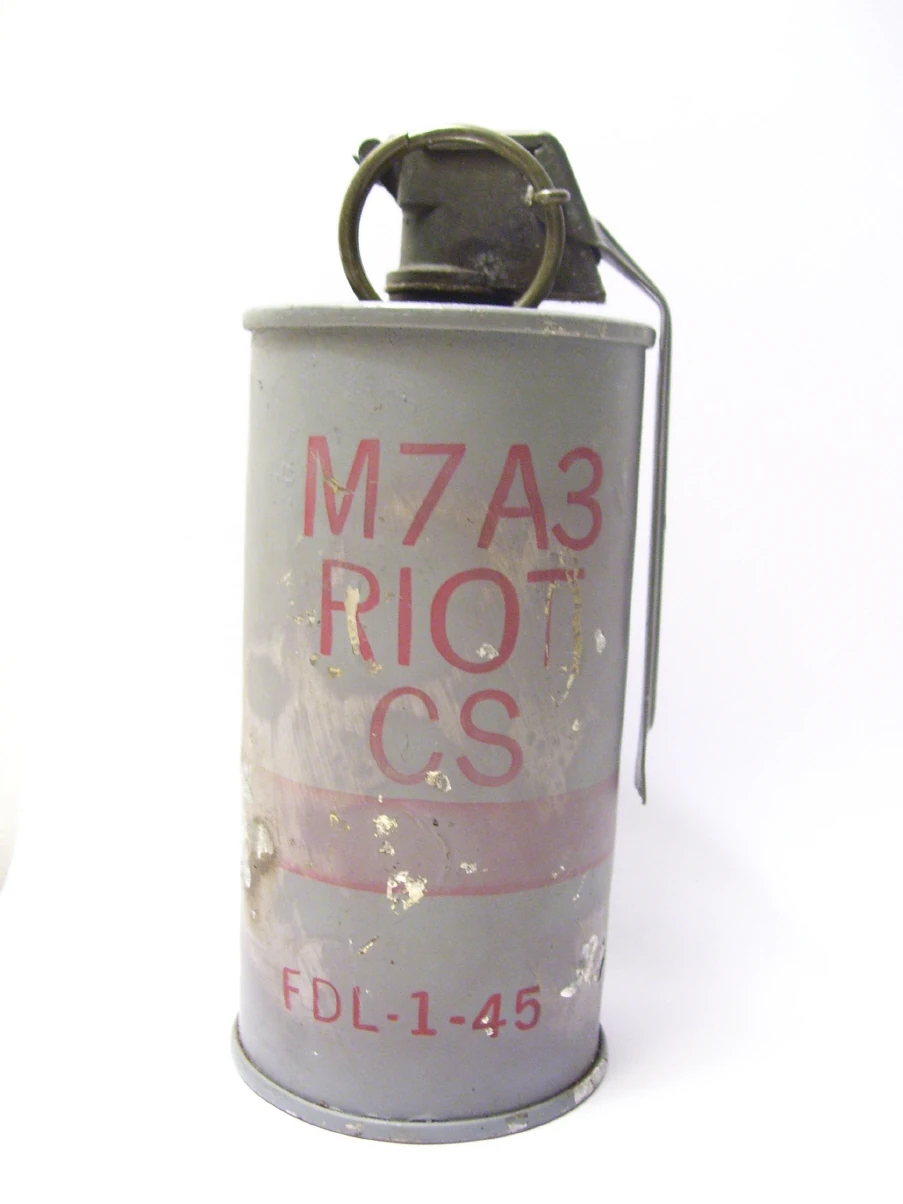
Burn time: 15–35 seconds. Effective radius: ~10 meters. Wind direction is critical — always check before deployment.
- Used to control riots and disable threats without serious injury.
- Disperses CS (tear gas) over a wide area.
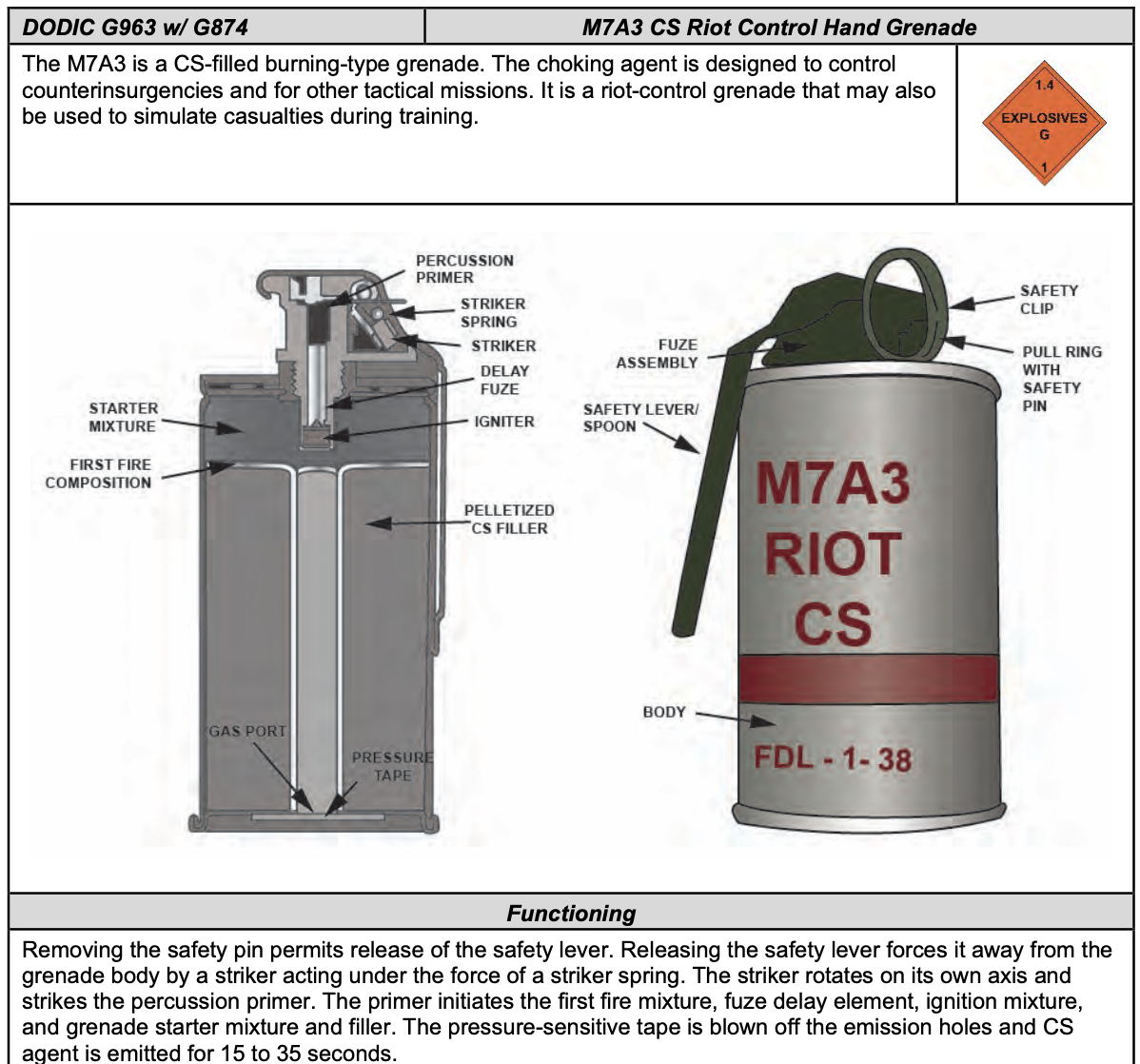
Grenade Usage
The essentials of grenade employment include gripping, preparing, removing the pull ring, and throwing.
Gripping
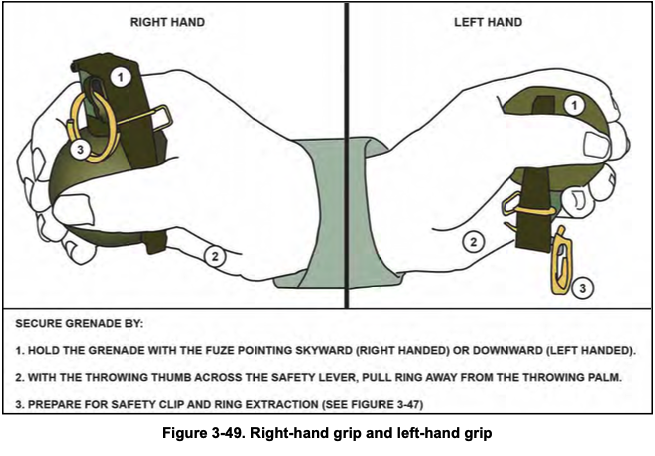 Apply enough pressure to firmly grip the grenade. The safety lever must remain depressed by your thumb.
Apply enough pressure to firmly grip the grenade. The safety lever must remain depressed by your thumb.
Preparing
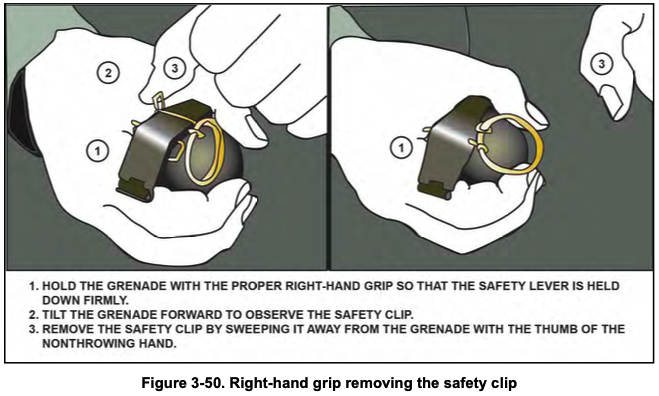 Use the non-throwing hand to sweep away the safety clip and secure the pull ring.
Use the non-throwing hand to sweep away the safety clip and secure the pull ring.
Do not remove the safety pin/clip until the grenade is ready to be thrown.

Added Tip: For left-handed throwers, invert the grenade so the fuse well faces down and the pull ring is accessible.
Throwing
Use the following positions when throwing grenades:
- Standing
- Prone-to-standing
- Kneeling
- Prone-to-kneeling
- Alternate prone
Follow these general steps when throwing grenades:
- Observe the target and estimate distance.
- Grip the hand grenade properly.
- Prepare the hand grenade.
- Throw the grenade overhand so it arcs and lands on or near the target.
- Allow the throwing motion to flow naturally.
- Immediately seek cover or drop to the prone position with your ACH toward the blast.
Standing Position
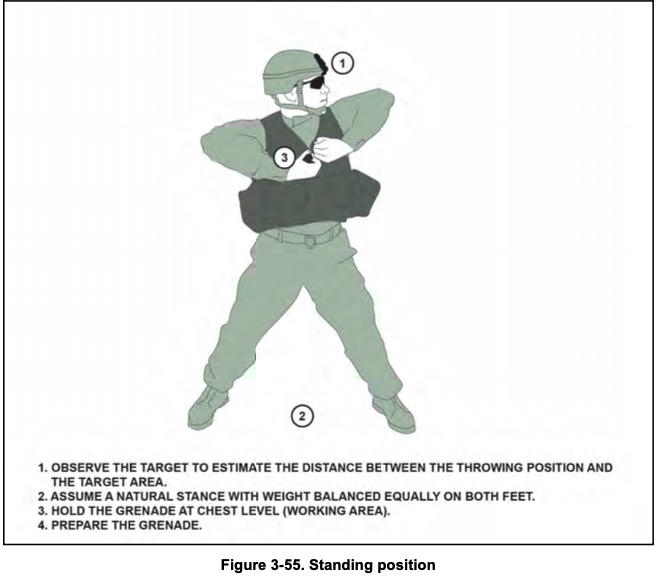
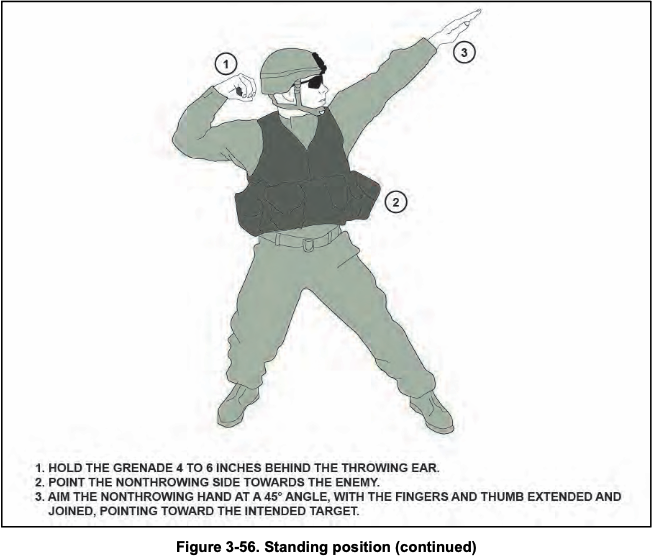
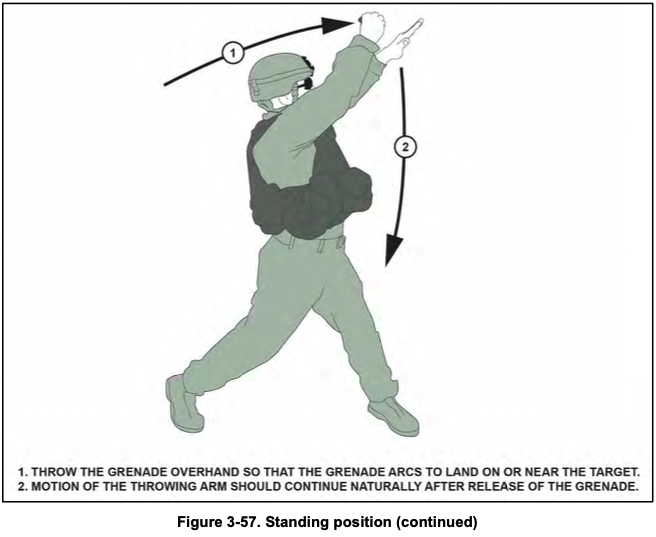
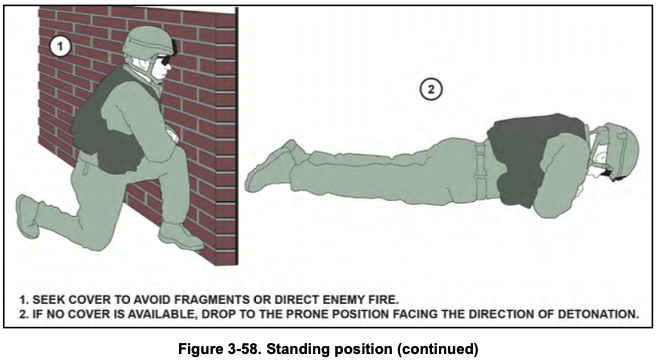
Kneeling Position
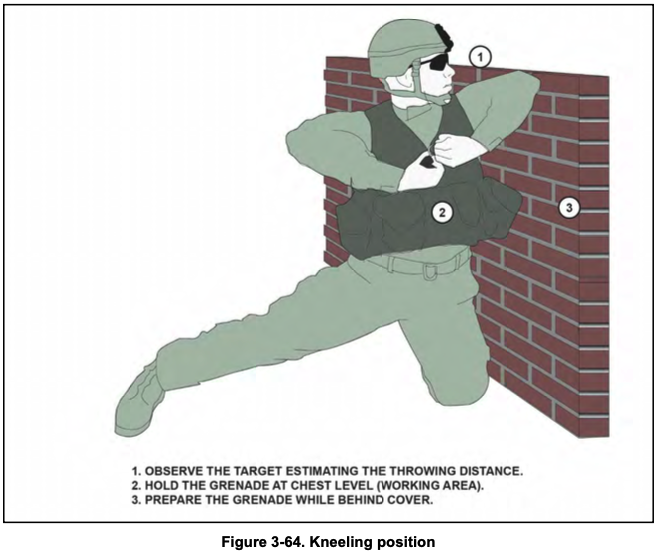

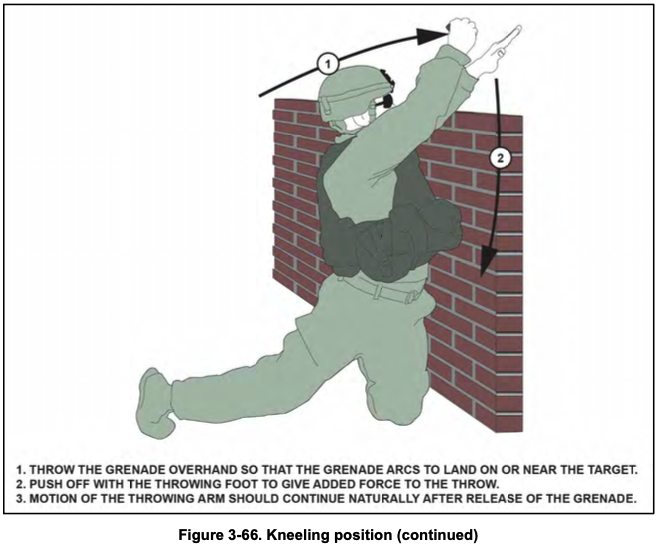

Added Tip: Practice with a baseball or tennis ball to develop muscle memory. Focus on arc, not distance — a high, looping throw is more accurate and safer.
Grenade Course
The grenade course includes a series of obstacles where you must throw the grenade into the target area.
There is also a grenade identification test at the end.
At CST, you’ll throw dummy grenades from bunkers and trenches.
Here are some sample obstacles you will encounter:
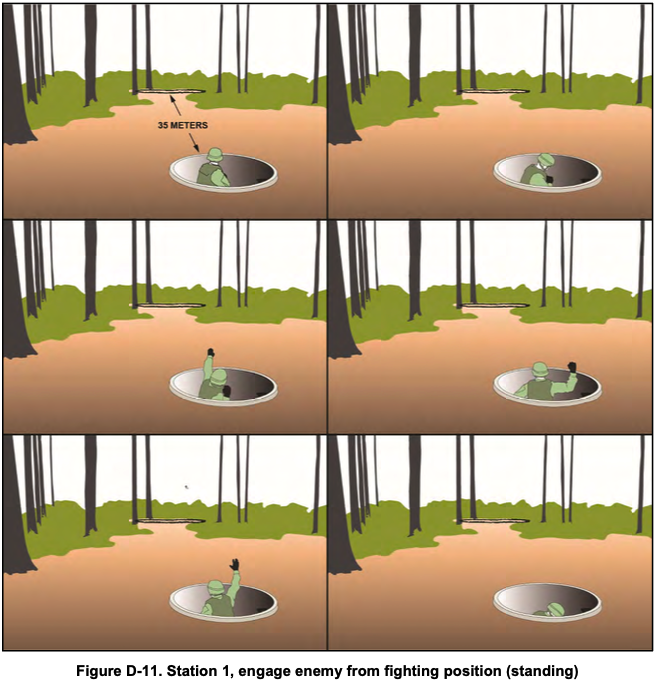
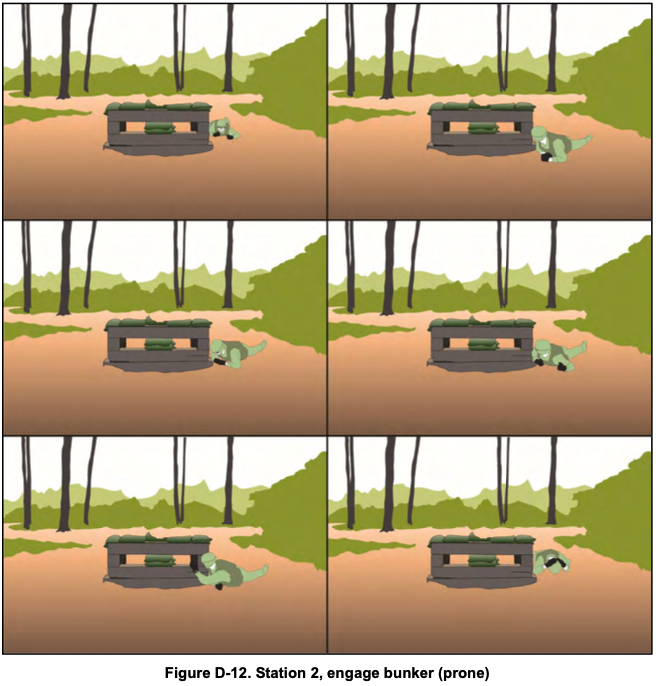
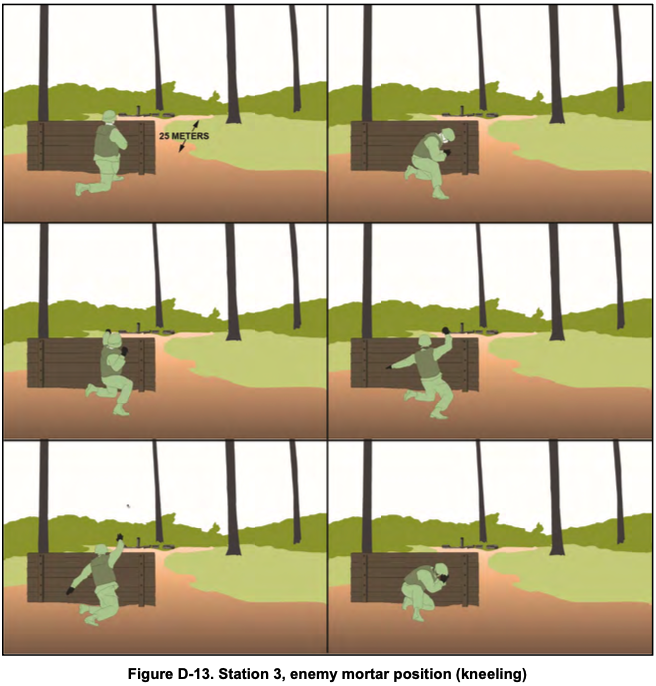
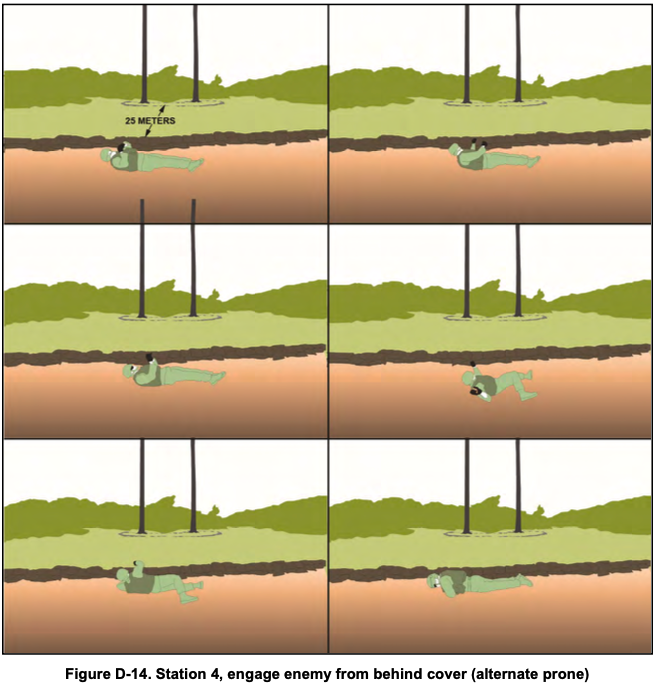

EIB Standard
Here are all the steps for grenade employment in the open according to EIB standards:
Task: Employ hand grenades.
Condition: You are a member of a team directed to employ hand grenades against troops in the open. You have two M67 fragmentation grenades.
Standard: Correctly perform all tasks, in sequence, within 30 seconds. One of the two grenades must explode within five meters of the target.
-
Select proper throwing position.
Note: There are five standard positions: standing, prone-to-standing, kneeling, prone-to-kneeling, and alternate prone. Use your own style if it improves distance and accuracy, as long as your body is sideways to the target and you throw overhand while maintaining weapon control.
a. Ensure you have a covered position.
b. Determine the distance to the target.
c. Align your body with the target. -
Grip the hand grenade.
Note: Do not remove the safety clip or pin until ready to throw.
a. Place the grenade in the palm of the throwing hand with the safety lever between the first and second joints of the thumb.
b. Keep the pull ring away from the palm so it can be easily removed by the index or middle finger of the free hand. -
Prepare the hand grenade.
a. Tilt the grenade forward to observe the safety clip.
b. Remove the safety clip by sweeping it away with the thumb of the non-throwing hand.
c. Insert the index or middle finger of the non-throwing hand into the pull ring up to the knuckle.
d. Hold the safety lever down firmly.
e. Twist the pull ring toward the body (away from the body for left-handed throwers) to release it from the confidence clip.
f. Remove the safety pin by pulling the pull ring. -
Throw the hand grenade so it lands within the effective range of the target.
a. Observe the target to estimate distance (no more than 3 seconds exposure).
b. Ensure no obstacles block the grenade’s flight.
c. Confirm body-target alignment.
d. Throw overhand with an arc so the grenade lands on or near the target.
e. Allow the throwing arm to follow through naturally.
f. Seek cover immediately or drop to prone with ACH toward the blast.
g. Prepare the second grenade.
h. Reengage if the first grenade did not explode within five meters of the target.
Conclusion
There are plenty of grenade types to memorize and critical safety rules to follow.
Best advice I can offer: practice throwing balls — throwing grenades is harder than it looks. Muscle memory and confidence are key.